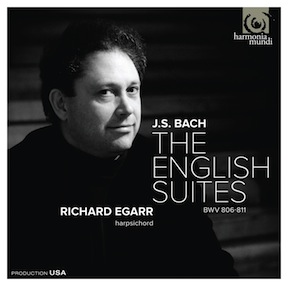 British period-keyboard master Richard Egarr, no stranger to Tafelmusik audiences, has released a recording of all six English Suites by J.S. Bach. The overriding impression from his interpretations is a vivid determination.
British period-keyboard master Richard Egarr, no stranger to Tafelmusik audiences, has released a recording of all six English Suites by J.S. Bach. The overriding impression from his interpretations is a vivid determination.
- Classical Music 101: What Does A Conductor Do? - June 17, 2019
- Classical Music 101 | What Does Period Instrument Mean? - May 6, 2019
- CLASSICAL MUSIC 101 | What Does It Mean To Be In Tune? - April 23, 2019
No matter how hard you hit a harpsichord’s keys, the instrument will make the same sound. Instead, a player varies dynamics with the use of stops.
The other way to get the sort of variety of sound that makes for a rich listening experience is to gently play with time, extending some notes ever so slightly to emphasize certain rhythms and/or harmonies — and vice versa.
To be fair, Egarr does provide a comfortable range of dynamics and tempos derived from the nature of each movement. But, on the whole, his strong underlying drive becomes a bit overpowering at times.
Egarr has thought through every aspect of what he is doing here, down to playing a modern Katzman reproduction of a Belgian harpsichord from 1638, which is more or less period-appropriate. Egarr has even devised his own temperament — the system for tuning the instrument — which is a sort of best-of adaptation he calls Temperament Egarr.
With all the repeats, this is a pile of music, covering 2 hours and 20 minutes on two CDs.
Each of the six English Suites (BWV 806 to 811) features a Prelude followed by a sequence of movements in the same key, all bearing the time signature and name of a courtly dance. The second movement is always an Allemande, the third a Courante (or two), the fourth a reflective pause in the form of a Sarabande and the finale a jaunty Gigue.
Between the last two movements Bach inserts Bourrées (Suites 1 & 2), Gavottes (Suites 3&6), Minuets (No. 4) and Passepieds (No. 5).
As Egarr writes in his album notes, there is nothing particularly English about these suites, which were written between 1717 and 1723, while Bach was working in Cöthen.
The pieces are, like so much of Bach’s writing, filled with all sorts of numerical symmetries and messages. Each suite also has a completely different character, despite on the surface being cut from the same pattern.
One thing I didn’t know that Egarr points out in his notes is that the notes of the key sequence of the six suites — A, a, g, F, e, d — represents the opening notes to the Lutheran chorale Jesu, meine Freunde.
I have a lot of respect for Egarr’s massive effort, but there are too many times when I wish he would have relaxed and breathed a bit more.
Listening to the suites in a marathon, I felt overhwelmed. Even though they all belong together, and Egarr recorded them together, they are best savoured in short installments.
For all the details on this release, click here.
John Terauds
- Classical Music 101: What Does A Conductor Do? - June 17, 2019
- Classical Music 101 | What Does Period Instrument Mean? - May 6, 2019
- CLASSICAL MUSIC 101 | What Does It Mean To Be In Tune? - April 23, 2019



